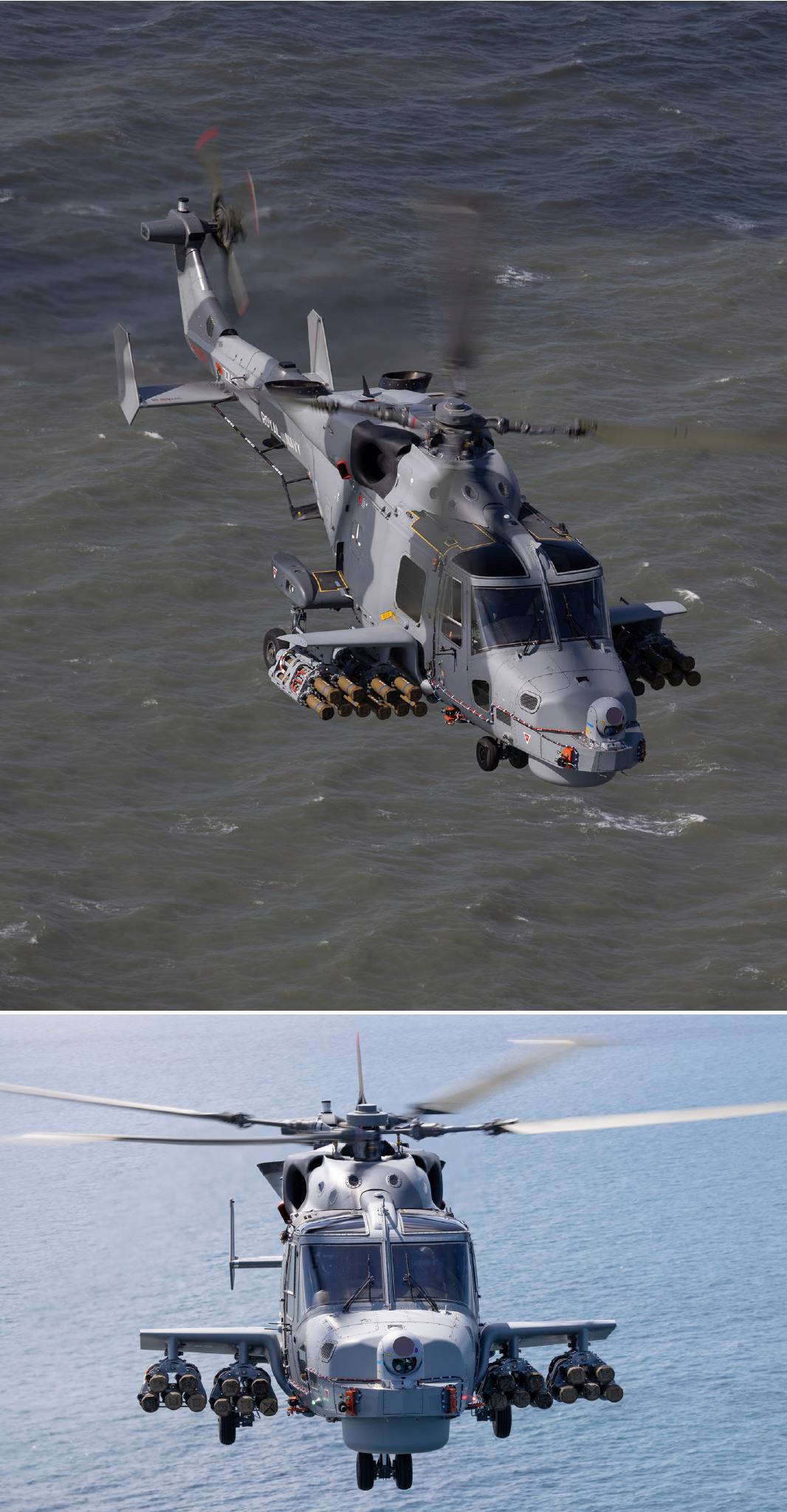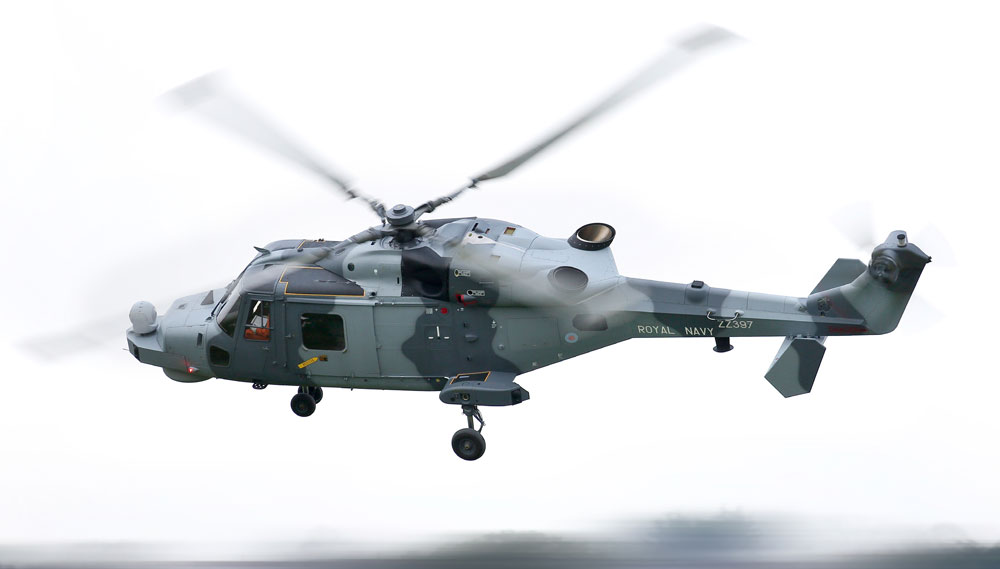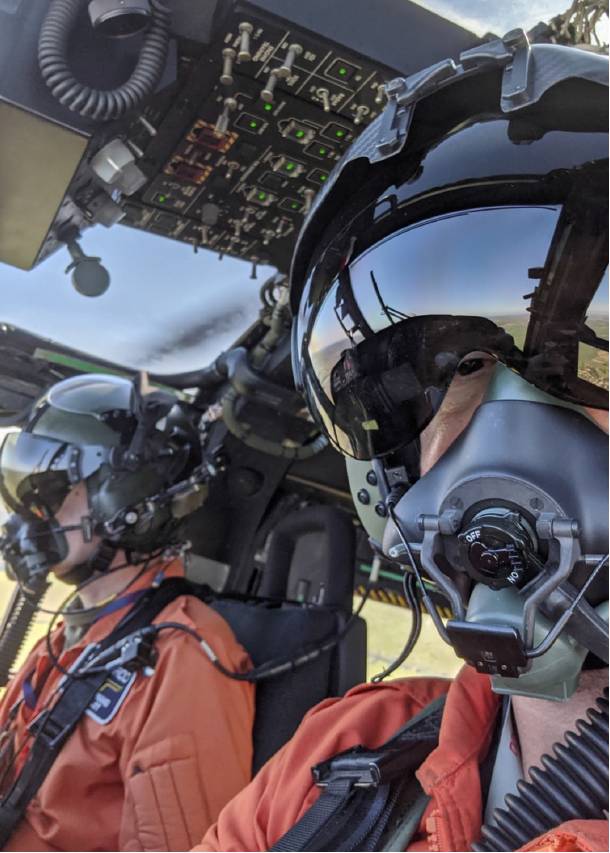DEFENCE Testing the Leonardo AW159 Wildcat
Taming the Wildcat
TIM ROBINSON FRAeS takes a closer look at recent improvements to the Leonardo Wildcat multimission helicopter – one of which, the DAFCS (Digital Automatic Flight Control System), resulted in the company winning the RAeS Bronze Team Medal in 2019.
 In May 2020 Royal Navy’s 815 Naval Air Squadron carried out the first live firing tests of the Thales Martlet lightweight
missile from a Wildcat. Royal NavyImagine – it is a dark, stormy night with zero visibility. You are flying a small helicopter hunting submarines, hovering low over forbidding dark water invisible below and trying to stay above a specific point at 50ft. Too low, and the waves could pull you into the sea. Too high, and the dipping sonar skims the waves, enabling your submerged prey to escape. Meanwhile, information is streaming in over radios and through datalinks to populate your screens – overwhelming your situational awareness. It is at this point that even a highly trained pilot could come close to ‘task saturation’ – potentially resulting in mission failure, or worse still, a fatal accident.
In May 2020 Royal Navy’s 815 Naval Air Squadron carried out the first live firing tests of the Thales Martlet lightweight
missile from a Wildcat. Royal NavyImagine – it is a dark, stormy night with zero visibility. You are flying a small helicopter hunting submarines, hovering low over forbidding dark water invisible below and trying to stay above a specific point at 50ft. Too low, and the waves could pull you into the sea. Too high, and the dipping sonar skims the waves, enabling your submerged prey to escape. Meanwhile, information is streaming in over radios and through datalinks to populate your screens – overwhelming your situational awareness. It is at this point that even a highly trained pilot could come close to ‘task saturation’ – potentially resulting in mission failure, or worse still, a fatal accident.
For a small helicopter with only a crew of two, this would seem to be at the limits of human performance. However, an Anglo-Italian team of engineers has successfully introduced a quantum leap in the capability of the Leonardo AW159 Wildcat helicopter, a platform which already has many functions to maintain situational awareness with a new Digital Automatic Flight Control System (DAFCS) – an achievement which garnered the team an RAeS Bronze Medal Award in 2019.
Fifth-generation helicopter
First flying over ten years ago in November 2009, the 62 AW159 Wildcats have now been delivered to UK forces (34 to the British Army, 28 to the Royal Navy) with the RN declaring initial operating capability (IOC) in January 2015. Export customers have been the South Korean Navy (ROKN) with eight AW159s and the Philippines with two.
Despite external appearances, the AW159 Wildcat multi-mission helicopter is a far different beast than the original Lynx that first flew in 1971 – with Leonardo describing it as a ‘fifth-generation platform’, thanks to its range of sensors, tactical processor and open system architecture. Though it might be best known for its is anti-surface warfare (ASuW) and anti-submarine warfare (ASW) roles, Wildcats have expanded their missions from high-end warfighting, to humanitarian operations and even supporting the UK Government in the current Covid-19 emergency.
But it is the information advantage that delivers the biggest change. Leonardo describes it as ‘iPhone’ where new capabilities and functions can be added (almost) like apps. Says Louis WilsonChalon – Marketing Manager, Leonardo Helicopters UK, himself a former RN Lynx pilot of the Wildcat’s step-change in capabilities: “When Royal Navy Air Station Portland was in existence I could launch from there and, in two hours, achieve a good picture of what was going on in the eastern half of the south coast exercise areas in the Channel. Now, if a Wildcat launched from Yeovilton, which is nowhere near the sea, by the time it’s got to Dorchester, which is about 10 minutes into the flight, the crew would know everything that’s going on in the whole of the Channel from the southwest approaches to the Dover Straits and it probably has got the time and the capacity to have a look down and see what’s going on in the Bay of Biscay.” Using the Wildcat’s powerful Seaspray AESA radar, SAGE ESM and Wescam EO/IR camera has thus seen tactics evolve from sea-skimming at low-level to perching at 7,000ft to survey wide swathes of the battlespace.
Leonardo UK Chief Test Pilot, Mark Burnand, himself, a former Army Lynx and Apache pilot agrees: “The poor old Lynx, love it though I do, it is back in the dark ages. You really can’t compare the Wildcat to the Lynx – its a quantum leap”.
However, this massive increase in situational awareness and sensor fusion comes at a price – that of increasing the cognitive load on the crew – a critical factor in a two-person platform.
Teaching the Wildcat new tricks
POOR OLD LYNX, LOVE IT THOUGH I DO, IS BACK IN THE DARK AGES. YOU REALLY CAN’T COMPARE THE WILDCAT TO THE LYNX – ITS A QUANTUM LEAP.
Mark Burnand Chief Test Pilot, Leonardo UK
The capabilities of this helicopter and the amount of data and information it can now present to its crew meant that in many ways it was now the airframe and flight control system that was limiting the platform reaching its full potential. Enter DAFCS – or Digital Automatic Flight Control System. This system effectively introduces a ‘pseudo-fly-by-wire’ system into an analogue helicopter, while retaining the mechanical control links. This four-axis autopilot system represents a quantum leap in stability, flightpath control and safety – while reducing the workload of the crew. This means the helicopter can now be effectively flown hands-off like a modern airliner.
DAFCS allows precision hovering in all weathers, 24/7, or a helicopter to enter a search pattern or a hands-off pull-up and hover in zero or poor visibility. Like modern airliner autopilot panels, altitude can be set by rotating – making ‘level busts’ in crowded and complex airspace a thing of the past. Another DAFCS capability adds a ‘mark on target’ button – pressed overhead the survivor, the aircraft automatically flys a circuit and transitions to a low hover into wind and with the survivor in the one o’clock position at 50ft. This is a function extremely useful when the crew might momentarily glimpse a head (or a periscope) bobbing above the waves. Indeed, in the example of night ASW that opens this feature, the system is not only sophisticated enough to maintain an exact position over the sea (despite any wind) but also uses the radar altimeter and filtering algorithms to even out the wave height – to ensure that dipping sonar stays submerged or that a rescue hoist stays at a constant height.
DAFCS also allows for coupled navigation and approach modes – increasing flight safety. Another safety feature is an automatic ‘wings-level’ function - which will recover the aircraft into wings-level flight and climbing safely away from terrain in the event of pilot thus helping to prevent CFIT (Controlled Flight Into Terrain) or aircraft limit exceedance. While not an Auto-GCAS recovery system, the aircraft does have a low height safety feature that can prevent inadvertent descents or continuing flight into rising terrain.
As well as the obvious benefits of safety – there are other advantages for military users. It essentially turns a two crew helicopter into a ‘three/four person’ crew – giving the pilot much more cognitive space to support the second crew member in prosecuting the primary mission, rather than focusing mainly on flying. This allows the crew to focus on the primary task, employing sensors or weapons – boosting the mission effectiveness of this small rotary-wing platform.
 Leonardo Helicopters
Leonardo Helicopters
Another advantage in this as a ‘pseudo-FBW’ system in that the mechanical control linkages are still used – so quadruple redundancy is not needed. That means that, should the dual computer DAFCS fail (perhaps through battle damage), the Wildcat would simply revert to being an analogue hand flown helicopter and the pilot would be able to fly the aircraft back to the home base, or even continue the mission itself – albeit at a reduced level of effectiveness.
While allowing the pilot to pull max collective and break engine limits if needed, DAFCS also includes a power limiting function and monitors system, sensors and actuators – protecting the transmission and engines from overstress. This, in turn, translates into lowered maintenance costs.
Finally – having done the hard work of adding this digital system, new functions and modes can now be patched in via software. Full auto-land on a moving ship, for example, says Burnand is “still a little way off, but they’re definitely things that we’re considering. Once you’ve got an aircraft which is well stabilised and where you’ve got full control over how it flies, you can do things like expand those kind of capabilities. There’s auto-land and auto take-off as well. Even things like if you lose an engine during the take-off there are automated profiles that the aircraft can fly, which we have trialed and are potential future enhancements.”
Going digital in this way also opens the path to optionally piloted or UAV applications – something that Leonardo has already been working on with its SW-4 Solo demonstrator. Says Wilson-Chalon of the potential of UAS rotorcraft: “The weak link in modern high-end aircraft like this is becoming the air crew.”
Challenges
However, adding this system to the Wildcat was not without its challenges, according to the flight test team. It has to be remembered that a helicopter is inherently unstable itself, unlike say an A320 where, even if the FBW system were removed, it would generally continue on its path thanks to aerodynamics and stability. This makes adding a ‘pseudo-FBW’ to a rotary-winged platform (especially a small, light one such as the 6t Wildcat) a significant task.
 Leonardo is now conducting flight testing using oxygen masks connected to PPE filters to protect crews from the Covid-19 pandemic. Leonardo Helicopters
Leonardo is now conducting flight testing using oxygen masks connected to PPE filters to protect crews from the Covid-19 pandemic. Leonardo Helicopters
Indeed the Wildcat, unlike other helicopters that have similar systems (such as the Chinook) is a small, agile and highly manoeuvrable chopper that is sensitive to pilot inputs and gusts of wind. Adding then a ‘pseudo-FBW’ to such an agile platform, a key challenge is not to lose the type’s handling characteristics. Says Burnand: “The Wildcat has inherited the impressive control response and agility made famous by the various aerobatic Lynx display teams over the years. This heritage allows it to land safely on pitching and rolling decks in extreme conditions, and operate in the mountains in extreme turbulence, when a lot of other aircraft are tucked up in the hangar. Our challenge was to maintain this agility when the pilot needs it but also to allow the aircraft to safely and effectively fly itself when required, and for the system to be clear when the pilot was in the loop and manoeuvring the aircraft. The pilot always gets the last vote and can override all modes of the autopilot!” He adds: “It’ll probably feel a little bit different but I think the pilots agree that it is close to what it would have been on the Lynx”.
Notes Burnand: “As test pilots, we love testing the handling qualities of an aircraft. Classic envelope expansion, tuning the stability and control characteristics of the aircraft is very satisfying. For these guys, that is one of the big challenges. Building an aircraft from scratch is relatively straightforward. When you’ve got the additional constraint of trying to recreate, digitally, the same handling qualities and add capability into an existing platform, with all the space and everything else you’ve talked about, it’s quite a challenge but hugely satisfying as well.”
A second challenge is that of retrofitting this system into the confines of a small platform such as the Wildcat. Though the system does not take up much space or weight, integrating the two new flight control computers into the existing avionics bay involved a substantial amount of rewiring and converting analogue interfaces to digital ones. A pilot’s control unit was also added to the cockpit to enable the pilot to control the different flight modes.
Finally – adding DAFCS was also done under tight timescales for the launch customer – the Republic of Korea Navy (ROKN). The upgrade was launched in 2013, with a first flight in 2014 and customer acceptance at the end of 2015.
Despite these challenges, a major advantage of developing the DAFCS in house, says Andy Handcock, an Avionics Engineer on the team, was the ability to respond rapidly to customer requirements. “The main reason is flexibility. Because we built the software in-house, it means that we can tailor and configure the system and performance relatively quickly, if there’s changes required by a customer.”
Flight testing in the age of Covid-19
While this leveraged work elsewhere in Leonardo on automatic flight control systems, it was the first DAFCS DO-178B Level A system to be designed, developed and tested in the UK. The design phase saw user requirements developed in conjunction with test pilots and HMI experts, which then progressed to rig testing (‘we did as much we could in the rig’) and finally test flights to wring out and fine-tune the system and push it to the limits. This saw the DAFCS capabilities expanded though an incremental flight test campaign in day and night, with the ultimate challenge of zero-visibility hover testing, with a sea state of 6 (12ft swells), and 50kt of natural winds.
Today, Leonardo is undergoing a particularly busy period in flight testing, supporting Wildcat weapons trials, Merlin HC4/4A and the AW101 Crows Nest all on the go at the same time. Adding to the activity is the complication of doing it while in the middle of a major pandemic. To that end, the company has introduced ‘remote working’ measures for its staff and also modified standard helmet and oxygen masks to use industrial PPE filters connected to hoses. Though test pilots will wear gloves, special attention too is being paid to cleaning switches, buttons and controls after every flight.
Extra claws for the Wildcat
As well as the DAFCS for ROKN helicopters, this year is also turning into a significant one for Royal Navy Wildcats with the addition of new anti-surface weapon systems – including the Thales Martlet and MBDA Sea Venom missiles. In May, the Royal Navy and Leonardo completed flight testing of the lightweight Martlet missile, with a Combined Test Team of LH(UK) and MOD Flight Test crews carrying out a firing trial on the 24 May off the coast of Wales. These weapons are carried on stub wings (that also provide some lift) with the Wildcat able to carry a staggering 20 Martlets. This gives the helicopter a lethal punch against adversaries using large numbers of small boats in ‘swarm tactics’. Set to receive IOC in October 2020, Martlet will be followed by the larger Sea Venom – enabling FAA Wildcats to engage larger surface targets – replacing the older Sea Skua missile. The Wildcat then, will be a key part of HMS Queen Elizabeth’s layered defence when the carrier and its strike group deploys on the first cruise in 2021.
The future
DAFCS and future software upgrades then opens up further growth potential for the already impressive Wildcat, such as auto-land, auto take-off or automatic weapon release modes, tactical approaches, or RNAV approach modes – enhancing safety and allowing this small multi-role helicopter to punch significantly above its weight. DAFCS, although not yet procured by the UK MoD for its Wildcats, also has the potential to boost the export sales of the AW159 despite tough competition. Not only does the system promise a leap in safety and mission effectiveness, it also crucially offers reduced maintenance and training costs – as well as a path towards UAV-teaming and an optionally-piloted future.
 In May 2020 Royal Navy’s 815 Naval Air Squadron carried out the first live firing tests of the Thales Martlet lightweight
missile from a Wildcat. Royal NavyImagine – it is a dark, stormy night with zero visibility. You are flying a small helicopter hunting submarines, hovering low over forbidding dark water invisible below and trying to stay above a specific point at 50ft. Too low, and the waves could pull you into the sea. Too high, and the dipping sonar skims the waves, enabling your submerged prey to escape. Meanwhile, information is streaming in over radios and through datalinks to populate your screens – overwhelming your situational awareness. It is at this point that even a highly trained pilot could come close to ‘task saturation’ – potentially resulting in mission failure, or worse still, a fatal accident.
In May 2020 Royal Navy’s 815 Naval Air Squadron carried out the first live firing tests of the Thales Martlet lightweight
missile from a Wildcat. Royal NavyImagine – it is a dark, stormy night with zero visibility. You are flying a small helicopter hunting submarines, hovering low over forbidding dark water invisible below and trying to stay above a specific point at 50ft. Too low, and the waves could pull you into the sea. Too high, and the dipping sonar skims the waves, enabling your submerged prey to escape. Meanwhile, information is streaming in over radios and through datalinks to populate your screens – overwhelming your situational awareness. It is at this point that even a highly trained pilot could come close to ‘task saturation’ – potentially resulting in mission failure, or worse still, a fatal accident.
